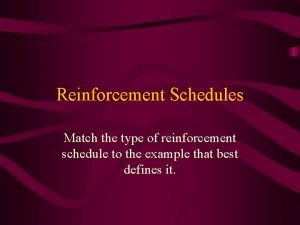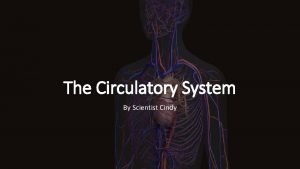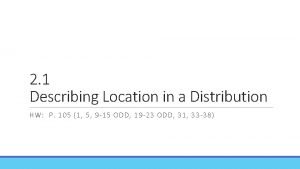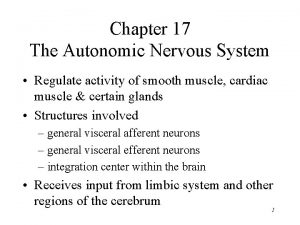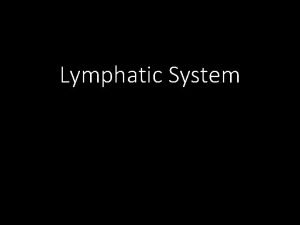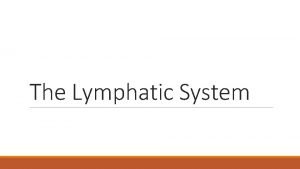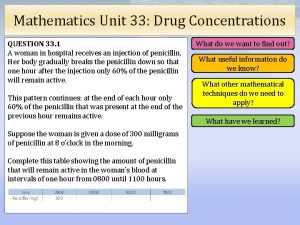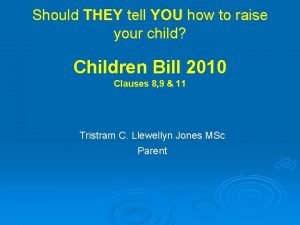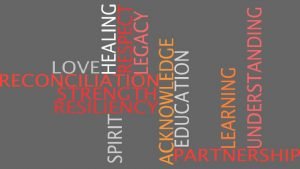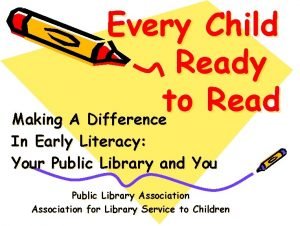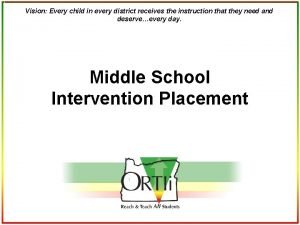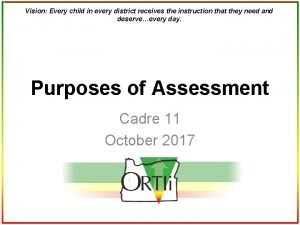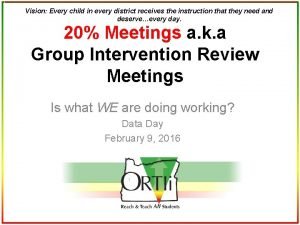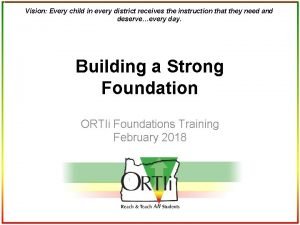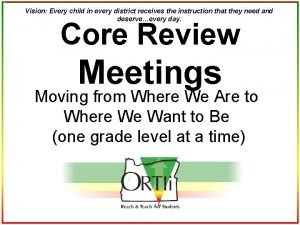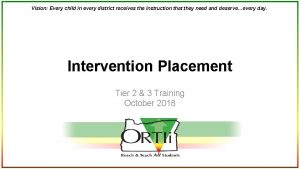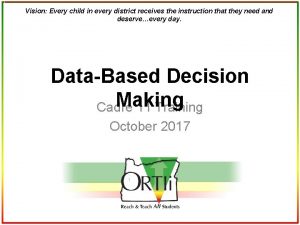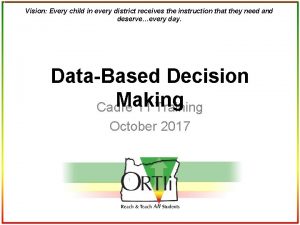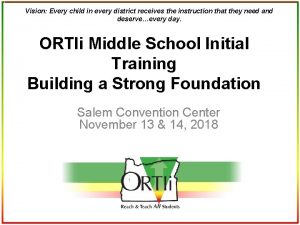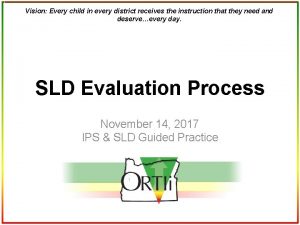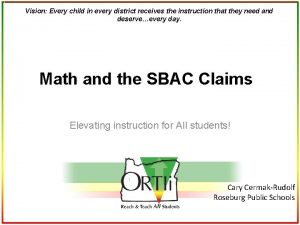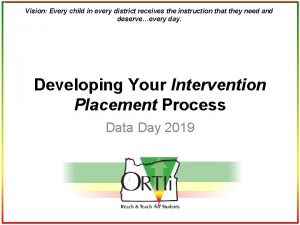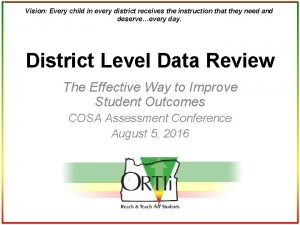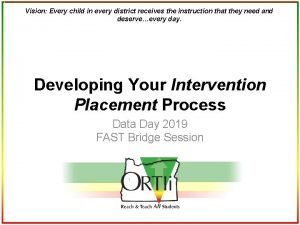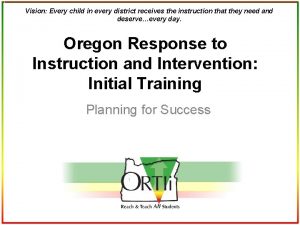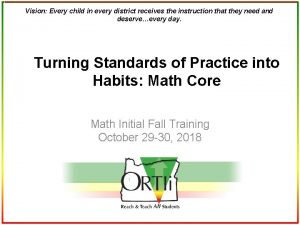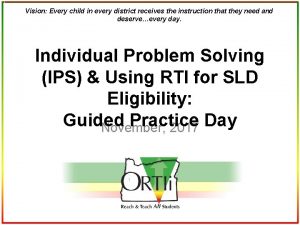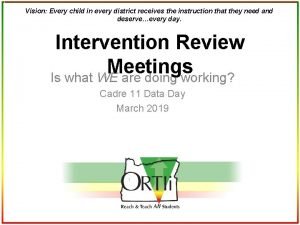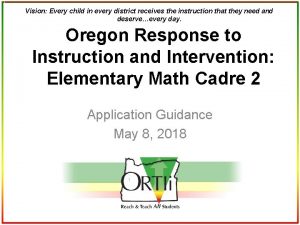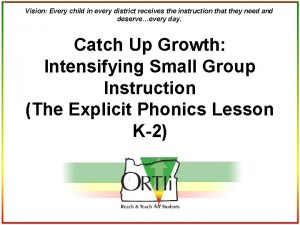Vision Every child in every district receives the
















































- Slides: 48

Vision: Every child in every district receives the instruction that they need and deserve…every day. Meeting Oregon’s Dyslexia Requirements through an RTI Model 2018 ORTIi Annual Conference Carrie Thomas Beck, Dyslexia Specialist, Oregon Department of Ed Shelby Di. Fonzo, ORTIi Implementation Coach

Targets • Gain general knowledge and background information on SB 1003 • Understand how SB 1003 fits into an RTI system • Explore tools needed for the 18/19 School Year – Universal Screening Measures – Family History Screeners • Understand how to intensify interventions based on knowledge gained for students exhibiting reading difficulties

SB 1003 Requirements • Districts must universally screen for risk factors of dyslexia in kindergarten using a screening test identified by the Department • The tests administered in kindergarten must take into account: PA, L/S correspondences, and rapid naming • Must screen for family history of difficulty in learning to read IF the student shows risk factors for reading difficulties, including dyslexia

SB 1003 Requirements • Districts shall screen students who first enroll in a public school in this state for first grade • The Department shall provide guidance for notifications to be sent by school districts to parents of students who are identified as having risk factors for reading difficulties, including dyslexia

OARs for Universal Screening: 581 -002 -1820 List of Approved Universal Screeners for Risk Factors of Dyslexia (1) The Oregon Department of Education shall develop a list of approved tests for universal screening for risk factors of dyslexia. (2) To be included on the list of approved tests, the screener must: (a) Have strong predictive validity, classification accuracy, and norm-referenced scoring; (b) Include measures of all of the following areas at least once per year in kindergarten: (A) Phonological awareness; (B) Letter-sound correspondences; and (C) Rapid naming. (c) Include measures of all of the following areas at least once per year in first grade: (A) Phonological awareness; (B) Letter-sound correspondences; (C) Rapid naming; (D) Word or pseudo word reading fluency; and (E) Oral reading fluency. (d) Include options for progress monitoring measures; and (e) Be cost effective. (3) The Oregon Department of Education shall annually review and update the list.

OARs for Universal Screening: 581 -022 -2445 Universal Screening for Risk Factors of Dyslexia (1) School districts must universally screen for risk factors of dyslexia in kindergarten using a screening test that is on the Department’s approved list referenced in 581 -002 -1820 and administering the measures in each area in 581002 -1820(2)(b) with fidelity as per guidelines of the test developers. (2) If a student first enrolls in a public school in Oregon for first grade, school districts must screen the student in first grade using a screening test that is on the Department’s approved list referenced in 581 -002 -1820 and administer the measures in each area in 581 -002 -1820 (2)(c) with fidelity as per guidelines of the test developers.


For all our assessments… What do we do with the data? How does it change the way in which we instruct our students? Let’s look at the current system through the lens of SB 1003!

Purposes of Assessment • Screening • Progress Monitoring • Diagnostic

Universal Screening Brief Reliable, Valid Standardized Culturally Appropriate

Universal Screening: Purpose • Why: 1. To determine the health of the core (Core Review Meetings) • Make instructional changes to improve core instruction 1. To identify students who may need additional instructional support (Intervention Placement)

IDA Fact Sheet

A screener cannot measure: • The future quality of your instruction • Availability of intervention supports at your school • Significant life events for a student that may impact achievement • If the student is having a good/bad day • Student interest in screener content • Distractions in the testing environment

What are some commonly used screening tools? Can be used for screening Curriculum-Based Measures (CBM) AIMSWEB DIBELS 6 th/DIBELS Next easy. CBM FAST Not appropriate to use for screening Quick Phonics Screener DRA Reading curriculum weekly/monthly tests or fluency passages Report Cards Running Records Fountas & Pinnell



Special Considerations for Screening for Risk Factors of Dyslexia

The Problem Is. . .

Progress Monitoring Brief Standardized Reliable Valid Equivalent Forms Is what we’re doing working?

Ways to monitor progress We want to know if Is the students are intervention successful inside working? your classroom. Curriculum-Embedded Assessments But, more importantly, Are they making we also want to know if enough growth to they are successful catch up to peers? outside your clas General Outcome Measures

Curriculum-Embedded Assessments vs. General Outcome Measures • Linked to specific • Research-based Progress • Measures taught skills Monitoring • Measures generalization • Given weekly to monthly interventions • Given daily/weekly Curriculum-Embedded Assessments General Outcome Measures

Curriculum-Embedded Assessments vs. General Outcome Measures • Mastery Tests • Unit/Lesson Tests • Checkouts • Exit Slips Curriculum-Embedded Assessments CBM measures • Phoneme Segmenting • Word/Non-word Reading • Oral Reading Fluency General Outcome Measures

Informal Diagnostic Assessments • The major purpose for administering diagnostic tests is to provide information that is useful in planning more effective instruction. • Diagnostic tests should only be given when there is a clear expectation that they will provide new information about a child’s difficulties learning to read that can be used to provide more focused, or more powerful instruction.

How do Informal Diagnostic Assessments fit in? If schools are implementing screening, progress monitoring and outcome assessments in a reliable and valid way, this should substantially reduce the need for additional testing using diagnostic assessments. What more can we reliably measure to If the informal diagnostic assessment provides guide instruction? additional information, will this information be useful in planning additional instruction for the students? Dr. Joseph Torgesen Florida State University and Florida Center for Reading Research

What our screeners tell us Lowest Scores Highest Scores On track Not on track Screeners can get muddy

Placement Tests

Sample Informal Diagnostic Assessments • • • Developmental Reading Assessment (DRA) Early Reading Diagnostic Assessment (ERDA) Fountas & Pinnell Quick Reading Inventory Running Records Qualitative Reading Inventory (QRI) Quick Phonics Screener Informal Reading Inventory (IRI) Diagnostic Assessment for Early Elementary Students (Really Great Reading) CORE Assessing Reading: Multiple Measures book San Diego Quick David Kilpatrick's Phonological Awareness Screening Test (PAST) SERC 4/9/12



Dyslexia perspective: Phonological Awareness, L/S Correspondences and Rapid Naming are included in the OARs for K Dyslexia perspective: Progress Monitoring drives additional informal diagnostic testing and helps to determine the need for family history screening Dyslexia perspective: Support further intensification/individualization of instruction



ORTIi Essential Components 9 Essential Components Clear Vision of Learning for ALL SLD Decision Making Core Initial and Progress Monitoring Ongoing Intervention PD Placement Interventions Ongoing BIT Meets Intervention Coaching Regularly Review Observe & Principal Universal Screening Actionable Decision Attends Feedback Rules RTI Core Materials and Instruction Meetings Leadership Growth Mindset & High Expectations For ALL Students Review Teaming & DBDM Culture Professional Learning Culture of Collaboration to Improve Outcomes

Meeting Oregon Dyslexia Requirements through an RTI Model The person At least Clear who has Progress Monitoring: one K-5 Vision of received • Family history screening for students that show risk on universal screening and teacher in Learning training do not make adequate progress each K-5 for ALL • Administer informal diagnostic assessments to intensify intervention as needed related to school dyslexia BIT Meets has would also Regularly received be an Universal Screening: training Principal important Screen for risk factors for dyslexia in kindergarten related to part of the Attends intervention dyslexia RTI (PA, L/S Correspondences, Rapid Naming) review team Meetings Leadership Growth Mindset & High Expectations For ALL Students Teaming & DBDM Culture Professional Learning One K-5 teacher in Culture of each K-5 school completes dyslexia Collaboration to Improvetraining Outcomes

ASSESSMENT INSTRUCTION Family History Screener Progress Monitoring Informal Diagnostic Assessments Universal Screening 3 times/year DATA-BASED DECISION MAKING Tier 3 Individualized Intervention Tier 2/3 Supplemental Intervention SPED Referral? Tier 2/3 Supplemental Intervention Research-Based Core Curriculum w/ Strong Instruction Individual Problem Solving Team 6 -8 weeks Intervention Review Team 6 -8 weeks Schoolwide Screening reviewed 3 times/year

Screening for Family History: OAR 581 -022 -2445 (4) If a student shows risk factors for reading difficulties, including dyslexia, school districts must screen for a family history of difficulty in learning to read. (a) A student is determined to show risk factors for reading difficulty, including dyslexia, if: (A) Based on test developer guidelines, the student shows risk on the universal screening test; and (B) The student does not make adequate progress, as indicated by the progress monitoring measures aligned with the universal screener, as the result of evidence-based reading intervention provided in addition to regular core instruction.

Screening for Family History: OAR 581 -022 -2445 (b) The screening for family history: (A) Must be completed no later than the next universal screening period according to test developer guidelines if a child continues to show risk on the universal screening test. Students who first enroll in a public school in kindergarten or grade one at the final universal screening period of the school year and show risk on the universal screening test will be screened for family history of reading difficulties immediately following the universal screening; (B) May be conducted verbally or in a written format; (C) Will consist of asking a parent or guardian if an immediate biological family member has experienced difficulty in learning to read, write or spell; (D) Will include questions related to the student’s developmental history; and (E) Will be completed and documented by the classroom teacher, data-review team member, or designee of the team.


RTI Team Structures Meetings Purpose Students Data Core Review effectiveness of ALL tiered systems of support and make adjustments Screening (CBM), Attendance, ODRs, SBAC Group Intervention Review Meetings (20% Meetings) To make changes for students in interventions Some students Progress monitoring (CBM) Individual Problem Solving Meetings To further intensify Few interventions for those in Students need Progress Monitoring (CBM)

Decision Rules • Provide the “now what” after teams have analyzed student data • Guide Decisions for all tiers • Take the guesswork out of “what to do next” • Ensure equity across schools I think… I feel… I believe What data do you have that makes you think/feel/believe that? -Dr. Ed Shapiro

How are Tier 2 Interventions Delivered? • Identify students’ needs • Group students according to needs • Align with core curriculum • Adjust time and intensity as needed

Intervention Matched to Student Need Making Meaning Oral Reading Accuracy & Fluency Phonics (Alphabetic Principle) Phonemic Awareness Vocabulary Reading Comprehension Foundational Skills

Kilpatrick (2015) Proficiency Advanced Phonological Awareness Orthographic Mapping

The “Formula” for Word-Level Reading Success: 1. Aggressively train phonological awareness to the advanced level; 2. Teach and/or reinforce letter/sound knowledge and skills (phonics); and 3. Provide extensive opportunities to read connected text. Kilpatrick, 2015

Interventions work when used correctly (a)the right kind and quality of instruction delivered with the (b)right level of intensity and duration to (c)the right children at the (d)right time. Joe Torgesen, “Catch Them Before They Fall”, American Educator, Spring Summer 1998

IDA Fact Sheet

IDA Fact Sheet • Critical Elements of Instruction: • Phonology • Sound/Symbol Association • Syllable Instruction • Morphology • Syntax • Semantics • Principles that Guide How the Elements are Taught • Systematic and Cumulative • Explicit • Diagnostic

Carrie Thomas-Beck, Ph. D. Carrie. thomas-beck@state. or. us 503. 947. 5833 & Shelby Di. Fonzo sdifonzo@ontario. k 12. or. us
 Every child every day
Every child every day Structured light
Structured light Child vision foundation
Child vision foundation 이진트리 복사 순회
이진트리 복사 순회 Types of reinforcement schedules
Types of reinforcement schedules Tribeculated
Tribeculated A wise man receives correction
A wise man receives correction Ligamentum arteriosum function
Ligamentum arteriosum function Mark receives a score report detailing his performance
Mark receives a score report detailing his performance Who teases romeo about rosaline and his love-sickness
Who teases romeo about rosaline and his love-sickness Miss cuba receives an invitation
Miss cuba receives an invitation Which target organ receives dual innervation
Which target organ receives dual innervation The boeing 747 is twice bigger than the boeing 707
The boeing 747 is twice bigger than the boeing 707 When earth receives energy from the sun, ____.
When earth receives energy from the sun, ____. Sternocostal surface of heart
Sternocostal surface of heart Short tube that receives purified lymph
Short tube that receives purified lymph Average weather conditions over time
Average weather conditions over time Chapter 7:9 lymphatic system
Chapter 7:9 lymphatic system A woman in hospital receives an injection of penicillin
A woman in hospital receives an injection of penicillin A computer company receives 350 applications
A computer company receives 350 applications Every child a seed
Every child a seed Tag question every mother loves her child
Tag question every mother loves her child Why was every child matters scrapped
Why was every child matters scrapped Every child matters be healthy
Every child matters be healthy Every child matters honouring and remembering
Every child matters honouring and remembering Every child is gifted they just unwrap
Every child is gifted they just unwrap Nparks every child a seed
Nparks every child a seed Pta every child one voice
Pta every child one voice Every child ready to read six skills
Every child ready to read six skills Microsoft mission statement
Microsoft mission statement Every picture has a story and every story has a moment
Every picture has a story and every story has a moment Every nation and every country has its
Every nation and every country has its Every knee shall bow every tongue confess
Every knee shall bow every tongue confess Every rotarian every year
Every rotarian every year Every nation and every country
Every nation and every country Tư thế ngồi viết
Tư thế ngồi viết Cái miệng nó xinh thế chỉ nói điều hay thôi
Cái miệng nó xinh thế chỉ nói điều hay thôi Cách giải mật thư tọa độ
Cách giải mật thư tọa độ Các châu lục và đại dương trên thế giới
Các châu lục và đại dương trên thế giới Bổ thể
Bổ thể Tư thế ngồi viết
Tư thế ngồi viết Thẻ vin
Thẻ vin V cc
V cc Thể thơ truyền thống
Thể thơ truyền thống Hát lên người ơi alleluia
Hát lên người ơi alleluia Hổ đẻ mỗi lứa mấy con
Hổ đẻ mỗi lứa mấy con Từ ngữ thể hiện lòng nhân hậu
Từ ngữ thể hiện lòng nhân hậu Diễn thế sinh thái là
Diễn thế sinh thái là Vẽ hình chiếu vuông góc của vật thể sau
Vẽ hình chiếu vuông góc của vật thể sau




